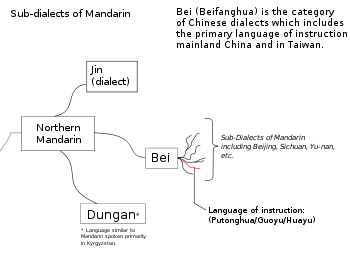- Northeastern Mandarin
-
This article is about the Mandarin Chinese spoken in the Northeastern part of China. For the standardized official spoken Chinese language, see Standard Chinese.
Northeastern Mandarin 東北話 / 东北话
DōngběihuàSpoken in Jilin, Heilongjiang and Liaoning provinces of the People's Republic of China; (Overseas, United States-New York City) Region Manchuria Native speakers 82 million (date missing) Language family Sino-Tibetan- Chinese
- Mandarin
- Northeastern Mandarin
- Mandarin
Language codes ISO 639-3 – Linguist List cmn-nem 
Northeastern Mandarin[1] is the dialect of Mandarin Chinese spoken in what historically was Manchuria. It is very similar to the Beijing dialect upon which Standard Chinese (Pǔtōnghuà) is based.
Contents
Geographical spread
The dialect is spoken by people in the Northeastern part of Mainland China; areas like Liaoning (except its southern part from Dalian to Dandong where Jiao Liao Mandarin is spoken), Jilin, and Heilongjiang provinces. With over 100 million people living in the Northeastern part of China, the Northeastern Mandarin-speaking population is quite large. Like other Mandarin dialects, differences between Northeastern Mandarin and other forms arise from the wide geographical distribution and cultural diversity of northern China. Overseas, Northeastern Mandarin is being spoken in increasingly larger communities in the Chinatowns of New York City in the United States.
Sub-dialects
Northeastern Mandarin can be subdivided into regional sub-dialects named for major cities where there might be slight differences.
- Changchun dialect (Simplified: 长春话/Traditional: 長春話)
- Harbin dialect (哈尔滨话/哈爾濱話)
- Qiqihar dialect (齐齐哈尔话/齊齊哈爾話)
- Shenyang dialect (沈阳话/瀋陽話)
Linguistic information
Usually, speakers of Northeastern Mandarin describe the variant that they are speaking as distinct from Standard Chinese. However, linguists classify Northeastern Mandarin as a form of Mandarin Chinese in a broader sense. While the difference between Northeastern Mandarin and Beijing dialect are not so significant phonologically, Northeastern Mandarin contains many colloquialisms not found in Standard Chinese.
Cultural and regional identity
Although not considered a language in academic circles, Mandarin variants like Northeastern Mandarin often contribute to a strong regional identity. Native or fluent Chinese speakers can usually recognize a Northeasterner by his or her accent (similar to how a fluent English speaker can assume a person with a Southern American English accent to be from the Southern United States). Because of its informal usage of words and tones, comedians often use Northeast dialects when performing.
Origins of the dialect
Northeastern Mandarin evolved from Han immigrants mainly from Shandong and Hebei provinces who settled Manchuria in the late 19th and early 20th centuries but it also retains elements from native Tungusic languages, Japanese and Russian and there are enough differences to give the dialect its own distinctive characteristics.
References
- ^ Chinese: simplified Chinese: 东北话; traditional Chinese: 東北話; pinyin: Dōngběihuà "Northeast Speech" or 东北官话/東北官話 Dōngběiguānhuà "Northeast Mandarin"
See also
- Chinese language
- Mandarin Chinese
- Standard Chinese
- Jiao Liao Mandarin
- Erhua
- Chinatown, Flushing
Chinese language(s) Major
subdivisionsNortheastern · Ji-Lu · Jiao-Liao · Zhongyuan · Southwestern · Lan-Yin · Lower Yangtze · Beijing · Dungan · Xuzhou · Luoyang · Jinan · Karamay · Nanking · Sichuanese · Kunming · Shenyang · Harbin · Qingdao · Guanzhong · Dalian · Weihai · Taiwanese Mandarin · Filipino-Mandarin · Malaysian Mandarin · Singaporean Mandarin · Chuan-puYueother MinDisputedUnclassifiedStandardized forms
(Ausbausprache)Phonology History Written Chinese OfficialHistorical scriptsOtherList of varieties of ChineseInner Mongolia topics General Geography Education Culture Music of Mongolia • Mongolian language • Mongolian script • Northeastern Mandarin • Plain Blue BannerCuisine Visitor attractions Categories:- Language articles with undated speaker data
- Languages with Linglist but no iso3 codes
- Mandarin Chinese
- Chinese
Wikimedia Foundation. 2010.

